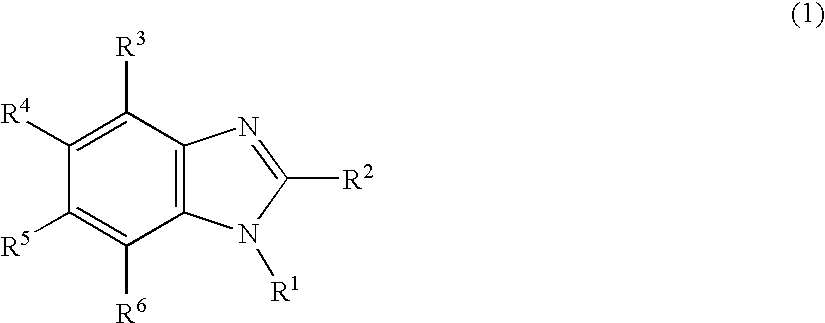Nitrogen-containing heterocyclic derivative and organic electroluminescence element using the same
- Summary
- Abstract
- Description
- Claims
- Application Information
AI Technical Summary
Benefits of technology
Problems solved by technology
Method used
Image
Examples
synthesis example 1
Synthesis of Compound (1)
(1-1) Synthesis of Intermediate 1
[0150]Into 50 ml of tetrahydrofuran, 5.0 g (0.015 moles) of 2-nitro-4-bromo-1-phenylaminonaphthalene was dissolved. While the resultant solution was stirred under the atmosphere of argon at the room temperature, a solution prepared dissolving 13 g (0.075 moles) of sodium hydrosulfite into 40 ml of water was added dropwise. Then, 5 ml of methanol was added, and the obtained mixture was stirred for 1 hour. To the resultant mixture, 40 ml of ethyl acetate was added, and then a solution prepared by dissolving 2.5 g (0.030 moles) of sodium hydrogencarbonate into 20 ml of water was added. To the obtained mixture, a solution prepared by dissolving 2.0 g (0.015 moles) of 4-bromobenzoyl chloride into 10 ml of ethyl acetate was added dropwise, and the obtained mixture was stirred at the room temperature for 3 hours. The resultant mixture was treated by extraction with ethyl acetate. The obtained extract was washed with water and a satu...
synthesis example 2
Synthesis of Compound (2)
[0153]The same procedures as those conducted in the synthesis of Compound (1) were conducted except that 10-naphthalen-1-ylanthracene-9-boronic acid was used in place of 10-naphthalen-2-ylanthracene-9-boronic acid, and Compound (2) was obtained as a light yellow powder substance. The amount of the obtained substance was 3.0 g (the yield: 64%). The obtained powder substance was identified to be Compound (2) by the measurement of the field desorption mass spectrum (FD-MS).
example 1
Preparation of an Organic EL Device
[0154]A glass substrate (manufactured by GEOMATEC Company) of 25 mm×75 mm×1.1 mm thickness having an ITO transparent electrode (the anode) was cleaned by application of ultrasonic wave in isopropyl alcohol for 5 minutes and then by exposure to ozone generated by ultraviolet light for 30 minutes. The cleaned glass substrate having the transparent electrode line was attached to a substrate holder of a vacuum vapor deposition apparatus. On the surface of the cleaned substrate at the side having the transparent electrode line, a film of N,N′-bis(N,N′-diphenyl-4-aminophenyl)-N,N-diphenyl-4,4′-diamino-1,1′-biphenyl (referred to as a TPD232 film, hereinafter) having a thickness of 60 nm was formed in a manner such that the formed film covered the transparent electrode. The formed TPD232 film worked as the hole injecting layer. On the formed TPD232 film, a film of 4,4′-bis[N-(1-naphthyl)-N-phenylamino]-biphenyl (referred to as a NPD film, hereinafter) havi...
PUM
 Login to View More
Login to View More Abstract
Description
Claims
Application Information
 Login to View More
Login to View More - R&D
- Intellectual Property
- Life Sciences
- Materials
- Tech Scout
- Unparalleled Data Quality
- Higher Quality Content
- 60% Fewer Hallucinations
Browse by: Latest US Patents, China's latest patents, Technical Efficacy Thesaurus, Application Domain, Technology Topic, Popular Technical Reports.
© 2025 PatSnap. All rights reserved.Legal|Privacy policy|Modern Slavery Act Transparency Statement|Sitemap|About US| Contact US: help@patsnap.com



